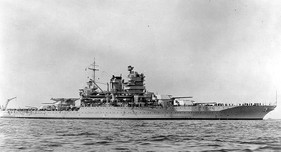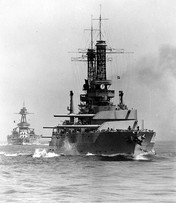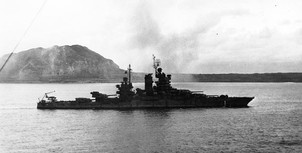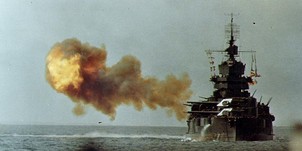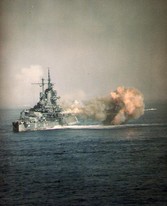24 March 1919 – Commissioned with Captain Carl Theodore Vogelgesang in command.
6 July 1919 – Gave transportation to President Pessoa of Brazil for the voyage from New York to Rio de Janeiro.
17 July 1919 – Joined the Pacific Fleet, visiting Alaska, California, Chile, Samoa, Australia, and New Zealand.
24 September 1925 – She operated out of San Pedro on training and readiness operations off California and in the Caribbean.
30 September 1931 – She entered Norfolk Navy Yard for modernization.
17 April 1935 – She returned to her home port of San Pedro. She carried out fleet tactics and gunnery exercises regularly until arriving with the battle fleet at Pearl Harbor 1 July 1940.
6 June 1941 – She sailed for Hampton Roads to perform Atlantic neutrality patrol, a vital part of U.S. policy in the early days of the European fighting. She moved to Iceland in September to protect American advance bases and was on station at Hvalfjordur when the Japanese attacked Pearl Harbor 7 December 1941.
9 December 1941 – She sailed with sister ship Mississippi to join the Pacific Fleet, via Norfolk and the Panama Canal, arriving at San Francisco.
31 January 1942 – She conducted additional battle exercises in California waters and out of Pearl Harbor until October 1942, when she entered Puget Sound Navy Yard to be re-gunned.
7 April 1943 – She sailed for operations in the Aleutians, where she was flagship of bombardment and patrol force around Attu.
11 May 1943 – She gave gunfire support to the Army landings on Attu Island, which was taken back from the Japanese. During the months that followed, she concentrated on Kiska Island, also taken by the Japanese.
15 August 1943 – She took part of the assault on Kiska, discovering that the Japanese had evacuated the island in late July, thus abandoning their last foothold in the Aleutians.
7 September 1943 – She returned to San Francisco to prepare for the invasion of the Gilbert Islands.
20 November 1943 – She arrived with the assault fleet off Makin Atoll. She supported the fighting ashore with accurate gunfire support and antiaircraft fire, remaining in the Gilberts until sailing for Pearl Harbor on 5 December.
31 January 1944 – She arrived off Kwajalein early soften up shore positions, until 5 February, when the outcome was one of certain victory. After replenishing at Majuro, she bombarded other islands in the group.
25 March 1944 – She returned to the New Hebrides, and after a short stay in Australia arrived at Kwajalein with a group of escort carriers on 8 June.
14 June 1944 – She began a pre-invasion bombardment of Saipan, then moved to Guam for bombardment assignments. As the American fleet destroyed Japanese carrier air power in the Battle of the Philippine Sea from 19–21 June, Idaho protected the transport area and reserve convoys and stood offshore providing vital support until anchoring at Eniwetok on 2 August.
15 August 1944 – She sailed to Espiritu Santo and entered a floating dry dock for repairs to her "blisters".
12 September 1944 – After landing rehearsals on Guadalcanal, she moved to Peleliu and began bombarding the island, needed as a staging base for the invasion of the Philippines, until 24 September.
22 October 1944 – She returned to Bremerton, Washington for needed repairs. The 5 in (130 mm)/25 cal guns were replaced by 10 5 in (130 mm)/38 cal guns in single enclosed mounts.
14 February 1945 – After rehearsals at Pearl Harbor, she arrived from the Marianas for the invasion of Iwo Jima. She remained off Iwo Jima until 7 March, when she underway for Ulithi and the last of the great Pacific assaults – Okinawa.
25 March 1945 – She arrived offshore and began bombardments. On 12 April, the battleship shot down five kamikazes before suffering damage to her port blisters from a near-miss. After temporary repairs, she sailed 20 April and arrived at Guam five days later.
22 May 1945 – She quickly completed repairs and returned to Okinawa on 22 May to resume fire support. Idaho remained until 20 June, then sailed for battle maneuvres in Leyte Gulf until hostilities ceased on 15 August.
16 October 1945 – Idaho arrived at Norfolk to wait for decommissioning.
 Project
Project